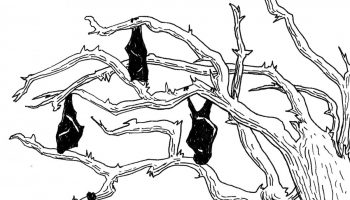Conservationists recently flipped over a rock in Chautauqua County to discover a four-legged, 2-foot-long salamander. Small, beady eyes stared back from either side of a slimy head at the end of an equally slimy body.
It was a hellbender, and they were ecstatic.
“The fact that we just added a 2-foot salamander to our county biodiversity list, that’s amazing,” said Twan Leenders, biologist and president of the Jamestown-based Roger Tory Peterson Institute of Natural History.
Hellbenders are the largest North American salamander, a dinosaur-vintage species that’s been crawling through fast-moving waters in the region for about 65 million years. Yet today, finding hellbenders in two parts of Chautauqua County is a big deal. Waterways mucked up with sediment and farming byproduct have driven the hellbender population to “near-threatened” status from the International Union for Conservation of Nature and Natural Resources, and Leenders said many, if not most, amphibians similarly inch toward the endangered list.
At 6:30 p.m. Monday, Leenders will lead a Lake Walk leaving from Heinz Beach in search of the amphibians living in Chautauqua’s South End Ravine.
Amphibians, one of Leenders’ specialties, spend part of their life cycle in water and another part on land. He’s studied amphibians in the rainforests of Costa Rica and Panama, informing his popular Costa Rica field guide published in 2001 and his conservation work at the Peterson Institute.
By themselves, amphibians are remarkable creatures. Consider frogs, which start out as tadpoles — “jellybeans with a tail,” Leenders said — and develop into leaping, ribbiting creatures. When winter drives animals into hibernation, certain frogs survive due to what’s essentially antifreeze in their blood. Those cryoprotectants prevent jagged ice crystals from forming in blood vessels, although Leenders said as much as 60 percent of a frog’s body freezes while it’s buried in the frostline.
“You can literally find a wood frog as the snow is melting that’s solid,” he said. “You can bang it on a table, and it sounds like a rock.”
Considered in the larger context of their ecosystem, amphibians form the nutritional foundation that makes a lot of animal life possible.
Most of a cold-blooded animal’s diet is converted to useful energy, whereas warm blooded animals “waste” energy maintaining a stable body temperature. That means frogs can spend their days snacking on insects and worms rather than hunting big ticket prey in the way a warm-blooded species must.
When a warm-blooded predator, such as a raccoon, eats a frog, it consumes the nutrition of those countless flies, mosquitoes and worms in a single piece of nutrition-rich prey. Rather than eating hundreds of times a day, the raccoon gets by on only a meal or two, freeing up the rest of the day to reproduce, sleep and do whatever else cute forest animals do.
In human terms: Why eat
a pack of rice cakes when you can have a steak?
As part of their duty, amphibians, particularly salamanders, eat all kinds of bugs — millipedes, termites, even roaches — that crawl along the forest floor. Together, those bugs are known as shredders, chewing up the dead plant matter that inevitably falls from the trees and ferns and bushes. Salamanders feast on these litter-eating shredders, leaving the plant matter to decompose into nutrient-rich soil.
Why is a little dirt so important? Leenders said soil encourages future plant growth that captures carbon dioxide, one of the greenhouse gases contributing to climate change.
“These are very recent findings, but it’s possible that our healthy salamander population may help us control the amount of carbon going into our atmosphere,” he said.
Yet, for all they do, amphibians are largely invisible. An average acre of forest in the northeast United States harbors more red-backed salamanders by weight than mammals and birds combined, Leenders said, and the Appalachia region is home to the world’s greatest diversity of salamanders anywhere.
But invisibility leaves many unaware of the amphibian’s disappearance; Leenders said one-third of the world’s amphibians face extinction, although that number could be as high as 85 percent due to lack of data.
Those amphibians, like Chautauqua’s flagging bat population, are in decline at the hand of several types of fungus. Leenders said the most concerning fungi can grow only on amphibian skin and spread an infectious disease called chytridiomycosis.
The disease causes layers of dead skin to build up, choking the amphibian’s blood flow and preventing it from regulating fluids and gases. In some cases, that means the amphibian can’t breathe. In other cases it produces lethargy and loss of certain reflexes. Those infected usually die, and there’s no effective way to control the spread of the fungus.
Although fungi are a global problem, Leenders said it’s actually less serious in the Chautauqua region. Instead, invasive plants such as garlic mustard are a big part of what’s edging out local salamanders.
With its clusters of small, white flowers and serrated leaves that produce (go figure) a garlicky scent, the invasive plant eliminates native plant species that form part of the salamander’s food web. Leenders said it’s more common to flip a rock in the woods where garlic mustard is found to discover nightcrawlers, another invasive species, where salamanders were once abundant.
Drought also affects amphibian populations that breed in pools formed by melted snow and spring rains. Without precipitation, those pools evaporate before amphibians complete their breeding. As western New York grapples with drought, Leenders said spotting amphibians in today’s Lake Walk isn’t guaranteed.
“In a way, these teeny, little creatures that most people see as slimy and creepy and crawly hold the key to some of our biggest environmental issues right now,” Leenders said.
Still, few hold donation drives for salamanders or devote their life to exterminating garlic mustard. “Who cares?” is a question Leenders fully anticipates, and his answer involves the chain reaction amphibian extinction could trigger.
“If in the process we lose everything in the food chain above salamanders, which is just about everything with a backbone, most people do care about that,” he said. “If in the process we lose the quality of our woods and let massive amounts of carbon go into the air, we would care about that.”






